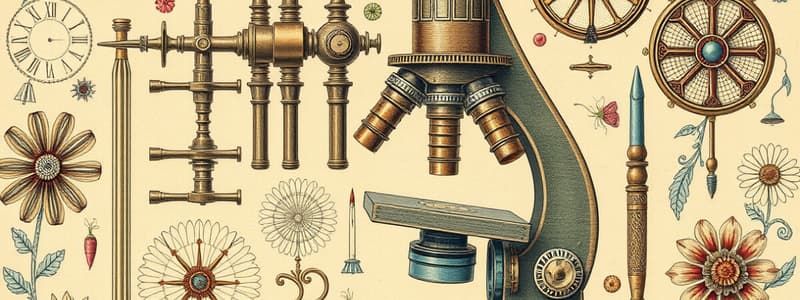Podcast
Questions and Answers
What does the coarse adjustment do?
What does the coarse adjustment do?
Moves stage up and down quickly to find a specimen on low power.
What is the function of the fine adjustment?
What is the function of the fine adjustment?
Used to make small focus adjustments.
What does the diaphragm do?
What does the diaphragm do?
Regulates the light that passes to the specimen.
What is the base of a microscope supposed to do?
What is the base of a microscope supposed to do?
How should the arm of the microscope be positioned when being carried?
How should the arm of the microscope be positioned when being carried?
What is the ocular or eye piece used for?
What is the ocular or eye piece used for?
What does the revolving nose piece contain?
What does the revolving nose piece contain?
What is the purpose of the body tube in a microscope?
What is the purpose of the body tube in a microscope?
What is the scanning objective or scanner's magnification?
What is the scanning objective or scanner's magnification?
What is the magnification of the low power objective?
What is the magnification of the low power objective?
What is the high power objective's magnification range?
What is the high power objective's magnification range?
What does the condenser lens do?
What does the condenser lens do?
What portion of the microscope allows the specimen to sit?
What portion of the microscope allows the specimen to sit?
What do stage clips do?
What do stage clips do?
Flashcards are hidden until you start studying
Study Notes
Microscope Parts and Functions
- Coarse Adjustment: Quickly moves the stage up and down for locating specimens under low power settings.
- Fine Adjustment: Used for precise focusing; only adjustment made when on high power.
- Diaphragm: Controls the amount of light reaching the specimen; can be a disc or iris type.
- Base: Must be flat on the table, approximately 5.0 cm from the edge; always supported when carrying.
- Arm: Should face the user; supported with one hand when carrying the microscope.
Optical Components
- Ocular or Eye Piece: First lens for viewing; typically magnifies 10x-15x, marked with a number for magnification level.
- Revolving Nose Piece: Holds 3-4 objective lenses; situated at the base of the body tube to allow changing objectives easily.
- Body Tube: Connects the ocular lens to the nose piece, aligned with the optical path.
Objective Lenses
- Scanning Objective: Shortest lens with 4x magnification; combined with the ocular for a total of 40x magnification.
- Low Power Objective: Medium length, magnifies specimens at 10x; results in 100x magnification with the ocular.
- High Power Objective: Longest lens, magnifies between 40x-50x; total magnification with ocular can reach 400x-500x.
Additional Components
- Condenser Lens: Located at the stage's center, focuses light onto the specimen for better visibility.
- Light Source: Provides illumination necessary for viewing specimens clearly.
- Stage: Platform where specimens are placed; height adjustments can be made using coarse or fine adjustment knobs.
- Stage Clips: Secure specimens in place to prevent movement during observation.
Studying That Suits You
Use AI to generate personalized quizzes and flashcards to suit your learning preferences.




